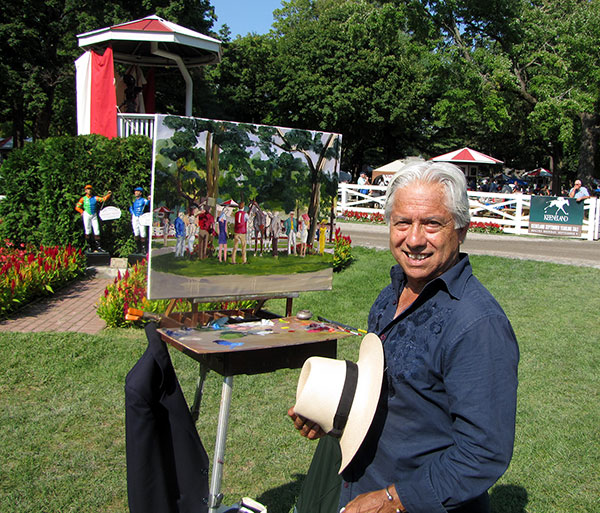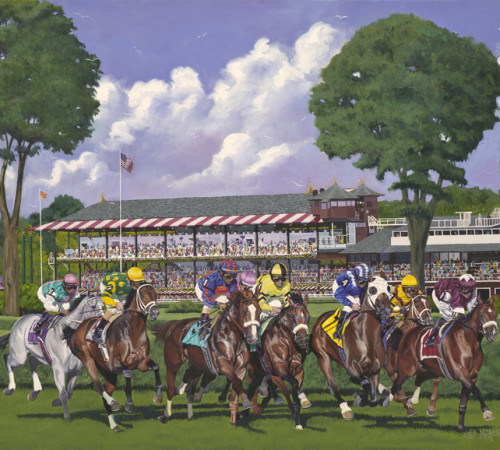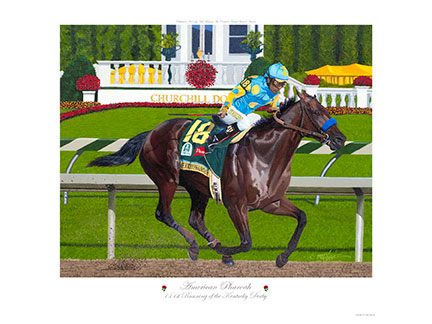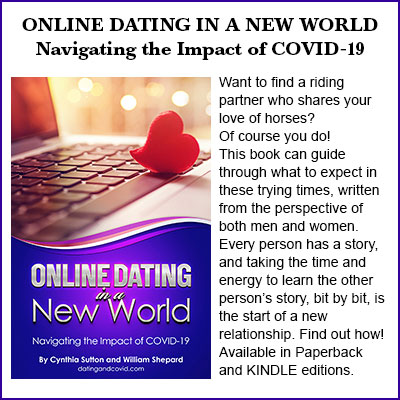
Saratoga Springs NY artist Nick Martinez, a native of Trinidad, Colo., was introduced to horses at a young age by his grandfather. He started his jockey career in 1976 at Centennial Race track in Colorado. In 1983, Martinez' career came to a halt when he shattered several bones in his leg in a riding accident. Nick endured a year and a half of physical therapy and in his spare time took drawing classes at a local art college in Phoenix, Ariz. After his leg was fully rehabilitated, he returned to riding for another six years. When he officially retired from race riding in 1991, Martinez continued work as an exercise rider while pursuing his art career on the side.
Martinez came to Saratoga, NY where he had his first art show. Due to his success at the upstate New York track, Martinez decided to make regular visits there to sell his equine art, and eventually decided to make Saratoga Springs, NY his permanent home. Martinez has been working as a full-time artist since 1991. In addition to portraits of various horsemen, jockeys, and horses, he also paints landscapes and other animals and was commissioned to travel to Africa and paint wildlife last winter (courtesy of www.nickmartinezart.com.)

EIE: Nick, it is an interesting transition from jockey to painter. Can you describe how you got involved with riding and then later as a jockey?
NM: Yes, my grandfather introduced me to horses at a very young age. I was riding when I was 3 and 4 years old. In high school, I would go to the racetrack La Mesa Park in New Mexico and walk "hots" and whatever needed to be done at the track.
When I got out of high school, I really wanted to go to the track but and but my father convinced me to delay a racing career and instead encouraged me to attend Casper Junior College, in Casper, Wyoming where I majored in art. I had thought I had to go into advertising to make a living but I read about famous jockeys and wanted to become a jockey.
After several tries at other training centers, I went to Keenland Acres in Fort Collins, Colorado where they broke and trained TB racehorses. They had over 300 horses on the property. The person who taught me was Elmer Keen who taught me to ride racehorses. His son Dallas Keen is a trainer at Lone Star racetrack in Texas.
Many of the horses we broke ended up at Centennial Race track in Littleton, Colorado where I started as a jockey. Based upon my experience at Keenland Acres, people gave me "live" mounts and my career immediately took off! From there an agent came and brought me to Del Mar in California.
I raced for 10 years but then had a terrible accident where my right leg was crushed from the knee to the ankle. I didn't know if I would ever walk again, much less ride. During the time that I spent recovering, I attended a local art college in Phoenix, Arizona and took drawing classes.
I ended up beating the odds and recovered well enough to walk, and even ride. I spent 18 months in physical therapy and rode again for another six years. Returning as a jockey was important to me, and I wanted to end my riding career on my own terms - not because of an accident. Eventually, I exercised horses in the morning which left my afternoons free to work on my art.
EIE:Do you think that having been a jockey gives you a different perspective as an artist?
NM: Definitely. Since I have been a jockey, I have been in the same position as most of my subjects. As a result, I put a lot more into a painting based upon what I know. I depict all of this in my art since I lived that life.
For example, I understand how the muscles around the hand tighten when gripping a whip or how a hand is flexed when gripping the reins. When riding a race horse, a racing "D" or snaffle bit is used and you have to grip the reins strongly and evenly. I also understand the balance of the jockey and how his or he toe is cocked, the weight distribution and hugging a horse over the withers. The experience I had helped a lot as I understand the physics of riding a horse.
I understand that when a horse is running, that the nostrils are open and contorting as the horse tries to get oxygen into its lungs. I know all the bones and muscles of a horse and how I can't overextend the ankle in a painting as it is an unnatural action. I know what it feels like as a horse thrusts its body into the next stride and if he's on the right or left lead - and I capture it in my paintings.
I understand how mud comes back on a horse. For example, if he's on the rail then mud would be on one side. I notice details that perhaps others may not notice, like if a jockey goes through three pairs of goggles in a race.
I create something I know is realistic. In my mind I feel like it gives me an advantage that I am familiar with horses on so many different levels by working around them all my life. I have worked in training centers, as a jockey, at sales and other countries like Mexico, Canada and England. I have a vast knowledge which I put into my painting. I try to recreate a moment in history thought my art.
All that knowledge does give me a better perspective on what I am doing. But I have seen some great artists that have never ridden, but they just "get it."

EIE: Describe the process of creating your works of art. Do you create a sketch on canvas from a live horse model or a photo first?
NM: I do create a sketch from a photograph some time. I always study the photograph to draw a running horse. That said I do paint from life as much as I can. In most paintings I use a combination of photos and from life.
Some people love realism and some like abstract paintings. I am more of a realist. For example, when VE Day won the Travers last year, I didn't want to make him "pretty" because he came from behind and he was covered in mud. I depicted him as the warrior he was by winning the race by a nose over Wicked Strong. The owner was very proud of her brave horse and thought the painting was beautiful.
EIE: Which was the painting which most moved you emotionally and why?
NM: When you ask which painting, it's like which horse did you enjoy riding. Since 1991 when I started I have painted hundreds of paintings they all moved me emotionally in some way. I try not to get attached to my work as I know they are all for sale.
EIE:You are currently painting in the paddock at the historic Saratoga racetrack. Please describe that experience. Tell us about interaction you have with racing patrons when they watch you create a work of art.
NM: I enjoy painting on location, there is a special energy at the race track. When you paint from life the painting in my mind's eye captures more depth, more dimension. The shadows define the lay of the land and forms throughout the painting.
EIE:You also sell greeting cards. How can someone purchase them from you?
NM: The cards I sell are note cards. Please call 518-744-3034. Prints can be purchased on m website: http://www.nickmartinezart.com/products-page/
EIE:Where can we see your work? Are your paintings displayed in galleries?
NM: www.nickmartinezart.com I sell everthing I paint so I seldom have paintings to display. I am fortunate that way as I don' have a lot of original inventory. I do sell limited edition prints online. I limited the number of prints for each piece.
EIE:You have gotten a lot of publicity for your beautiful work!
NM: Yes, I was profiled on ESPN, TVG and news outlets local to Saratoga Springs. NY.
EIE: Can someone commission you to paint a portrait of their horse? What is the best way to contact you?
NM: Yes, please call 518-744-3034 or text that same number.








